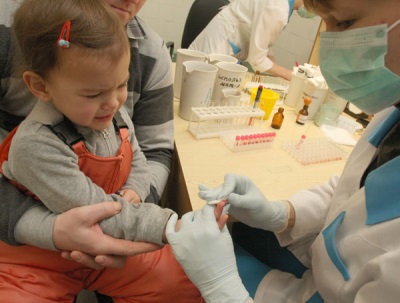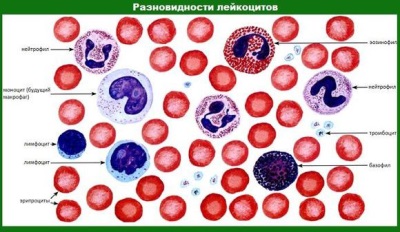Low lymphocytes in the blood of a child
When parents study the form with the results of a child’s blood test, they begin to worry about the health of the baby due to some indicators. For example, if there are few lymphocytes in the analysis, then each mother wants to know if it is dangerous for the child and what should be done with this analysis result.
What level is considered reduced
Lymphocytes are called one of the types of white blood cells that are involved in immune responses in a child’s body. The main function of such leukocytes is to protect the child from viral infections, as well as bacteria and other harmful factors.
In a blood test, lymphocytes are determined as a percentage of all leukocytes. The lower limit of the norm in children is the following level of these cells:
|
Newborns |
16% |
|
On the fifth day of life |
30% |
|
From the 10th day of life |
40% |
|
From 1 month |
45% |
|
In children over 5 years |
35% |
|
In children over 10 years old |
30% |
If, as a result of the leukogram, the percentage of lymphocytes is less than the indicated figures, this condition is called lymphocytopenia or lymphopenia.
Types of lymphocytopenia
Depending on the reason that provoked a decrease in the level of lymphocytes in peripheral blood, lymphocytopenia may be:
- Absolute. This decrease in lymphocytes is mainly due to insufficient production of white blood cells in the bone marrow. It is diagnosed in congenital or acquired immunodeficiencies, leukemia, chronic liver pathologies and in other cases. The appearance of this type of lymphopenia in a newborn poses a great danger to the life of the infant and can be fatal.
- Relative. It is caused by an increase in the number of neutrophils (neutrophilia). Most often, such lymphopenia is caused by an acute or chronic infection.
Also lymphocytopenia is divided into:
- Congenital It is caused by various congenital pathologies or diseases transmitted to the baby in utero from the mother.
- Acquired. Such a decrease in lymphocytes is due to the effect on the child of various factors after birth, for example, drugs, toxic substances or viruses.
In addition, there are acute lymphopenia, as well as chronic lymphocytopenia.
Causes of Lymphopenia
Lymphocyte deficiency occurs:
- With Wiskott-Aldrich syndrome, which is a primary immunodeficiency with lymphocyte damage.
- With congenital aplasia of stem cells involved in lymphopoiesis. The disease is manifested by leukopenia, anemia and a decrease in platelet levels.
- In acute surgical pathologies, for example, intestinal obstruction or appendicitis.
- With HIV infection, hepatitis, typhoid, measles, tuberculosis, polio and other infectious diseases.
- After stress, as well as in case of malnutrition (if the body does not receive enough proteins and minerals, especially zinc).
- When aplastic anemia caused by viruses, autoimmune processes, drugs or poisoning.
- After treatment with immunosuppressive drugs, as well as after chemotherapy.
- In rheumatoid arthritis, lupus erythematosus and other systemic diseases.
- After exposure to ionizing radiation.
- With extensive burns.
- With lymph node injuries or pathologies of the thymus.
- When enteropathy, because of which the child loses nutrients.
- In renal failure.
- With lymphoma.If at the beginning of such a disease the number of lymphocytes increases, then over time the bone marrow is depleted, which is manifested by lymphopenia.
- During the recovery period, when new lymphocytes were not yet formed in sufficient quantity.
Symptoms
A reduced level of lymphocytes does not show any specific symptoms, but for diseases that provoke lymphopenia, a child is often noted:
- Pallor or yellowness of the skin.
- Lesions of the oral mucosa.
- Frequent respiratory infections.
- Decreased lymph nodes or tonsils.
- Inflammatory diseases of the skin.
- Enlarged spleen.
What to do
If the blood test showed a low content of lymphocytes, it is important to establish the causative factor, as this will help in timely and correct selection of treatment for a child with lymphopenia. In many cases, treatment of the underlying disease helps eliminate the deficiency of lymphocytes.
At the same time, it is important for parents to remember that a low content of lymphocytes in the blood increases the risks of the appearance of infections and their complications in a child. Therefore, it is important to go with the child to the pediatrician immediately after detecting a decrease in these white blood cells. If necessary, the doctor will prescribe additional tests (immunogram, urinalysis, biochemical blood test) and refer the child to an immunologist, hematologist or oncologist.
Immunoglobulins are used to treat chronic lymphocyte deficiency or recurrent infections in children. In many cases, for successful treatment of babies with congenital immunodeficiency perform bone marrow transplantation.















